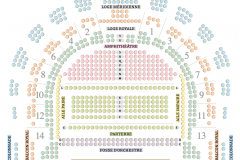Charpentier, Les Arts florissants
November 2025 | ||||||
|---|---|---|---|---|---|---|
Mo | Tu | We | Th | Fr | Sa | Su |
Charpentier: Les Arts florissants | Opera in concert
Performance in French with surtitles in French and English.
Concert for the 80th anniversary of William Christie
Musical idyll in five scenes composed for Marie de Lorraine, Duchess of Guise in 1685.
To close the anniversary season of his 80th birthday, William Christie chose a symbol: to share with the audience the short opera by Marc-Antoine Charpentier who gave his name to the ensemble… Les Arts florissants. Presented in a double format with another lyrical piece by the same composer, La Descente d’Orphée aux Enfers, this new show will also offer the opportunity to discover the ten new laureates of the Jardin des Voix, the international academy for young singers of Les Arts Florissants. A spectacular finale!
Les Arts florissants and Charpentier’s La Descente d’Orphée aux Enfers are part of the "origin story" of Les Arts Florissants, which have performed them since their earliest concerts. True gems of theatrical music, these pocket operas have been — and remain — remarkable experimental grounds. They include all the ingredients of baroque vocal art: choirs in the style of the Roman school, solos in the most eloquent declamatory style, airs in the style of courtly songs... as well as echoes of Lully’s comedies and tragedies, with typical overtures and lively, colorful instrumental pieces. These two masterpieces confirm Charpentier’s dramatic genius, whose impact on the audience remains a living proof today.
To bring them to life, this new production will harness all the energy and talent of the ten new laureates of the Jardin des Voix academy. These young singers, selected worldwide by William Christie and Paul Agnew, will perform together for the first time with the musicians of Les Arts Florissants. They will immerse themselves in the ensemble’s core repertoire: French music of the Grand Siècle.
A celebration of the arts, in which directors Marie Lambert-Le Bilhan and Stéphane Facco, together with choreographer Martin Chaix and his dancers, will participate to reveal all the flavor and emotion!
PRESTIGE VIP CATEGORY: The best seats in the hall, the program will be offered to you along with a glass of champagne.
PRESTIGE CATEGORY: Very good seats, the program will be offered to you along with a glass of champagne.
Program and cast
With the laureates of the 12th edition of the Jardin des Voix academy:
Josipa Bilić, Camille Chopin, Sarah Fleiss, Tanaquil Ollivier – Soprano
Sydney Frodsham – Mezzo-soprano
Richard Pittsinger, Bastien Rimondi – Haute-contre
Attila Varga-Tóth* – Taille
Olivier Bergeron – Baritenor
Kevin Arboleda-Oquendo – Bass
*Member of the Royal Opera Academy – class of 2023/2025
Dancers
Les Arts Florissants
William Christie, Conductor
Marie Lambert-Le Bihan and Stéphane Facco, Staging
Martin Chaix, Choreography
Program
Marc-Antoine Charpentier (1643–1704)
Les Arts Florissants
Performance in French with French and English surtitles.
Concert for William Christie's 80th birthday
Idyll in music in five scenes composed for Marie de Lorraine, Duchess of Guise in 1685.
Marc-Antoine Charpentier (1643–1704)
Les Arts Florissants
Intermission
Marc-Antoine Charpentier
The Descent of Orpheus to the Underworld
Palace of Versailles Opera Theater
Royal Opera
The Royal Opera of Versailles, located in the grounds of the Castle, one of the major opera houses.
The opening of the opera house at Versailles brought to a close a process of planning, projects and designs that had lasted for nearly a century. While the Royal Opera was finally built towards the end of the reign of Louis XV, it had been envisaged since as early as 1682, the year when his predecessor Louis XIV took up residence at Versailles. The King had commissioned Jules Hardouin-Mansart and Vigarani to draw up plans for a ballet theatre. Mansart shrewdly decided on a position at the far end of the new wing that was to be built over the coming years: the nearby reservoirs for the gardens’ fountains could be used to fight any fire that might break out, while the sloping ground on that part of the site would allow provision of the necessary technical spaces below the stage without major excavation work. So cleverly-chosen, indeed, was the planned location that none of Mansart’s successors ever questioned it.
Major building work was already under way in 1685, but was soon interrupted because of the wars and financial difficulties which beset the later part of the king’s reign. Louis XV in his turn was long put off by the huge expense involved in the project. As a result, for almost a century the French court was forced to put up with a makeshift theatre installed below the Passage des Princes. When a grand opera was required, with a large cast and complicated stage machinery, a temporary theatre would be built in the stables of the Grande Ecurie, with the entire structure being demolished once the performances were over. This temporary solution was adopted, for instance, during the celebrations of the Dauphin’s wedding in February 1745, but its inconvenience was so starkly obvious that Louis XV finally resolved to build a permanent theatre, entrusting its design to his first architect, AngeJacques Gabriel.
The process of actually building the new theatre, however, was to take over twenty years. During this lengthy period of construction Gabriel, who had studied the leading theatres of Italy, in particular Vicenza, Bologna, Parma, Modena and Turin, presented a series of different designs to his royal patron, none of which was accepted. Only in 1768, faced with the forthcoming successive marriages of his grandchildren, did the king finally give the order for work to commence. Building progressed steadily and the new opera house was completed in twenty-three months, ready for its inauguration on the 16th of May 1770, the day of the Dauphin’s marriage to the Archduchess Marie-Antoinette, with a performance of Persée by Quinault and Lully.
Royal Chapel
This extraordinary two-level palatine chapel was built by Jules Hardouin Mansart between 1699 and 1708 and completed by Robert de Cotte in 1710.
The paintings on the vaulted ceiling by Antoine Coypel, Charles de la Fosse and Jean Jouvenet, as well as the lavish decoration fashioned by a team of sculptors working for Louis XIV, depict a number of Old and New Testament scenes. Facing the royal gallery is the remarkable organ, created by Robert Clicquot, the King's organ builder, which was first played on Easter Sunday 1711 by François Couperin.
Even though Hardouin-Mansart did not witness the completion of the chapel, he was the one who had dictated the major aspects of the architecture and decor: a ground floor with a nave, aisles and ambulatory, and an upper floor with galleries, a harmonious combination of white and gold contrasting with the polychromatic marble floor and paintings on the vaulted ceiling, all combining to create an original space with references to both gothic architecture and baroque aesthetics.
Every day, generally at 10 a.m., the court would attend the King's mass. The King would sit in the royal gallery, surrounded by his family, while the ladies of the court would occupy the side galleries. The "officers" and the public would sit in the nave. The King would only descend to the ground floor for important religious festivals when he would take communion, for Order of the Holy Spirit ceremonies and for the baptisms and weddings of the Children of France, which were celebrated there between 1710 and 1789. Above the altar, around the Cliquot organ played by the greatest virtuosos of their age, including François Couperin, the Chapel Choir, renowned throughout Europe, would sing motets throughout the entire service, every day.
The Orangerie gardens
From May to October, orange trees and other shrubs are taken out of the Parterre Bas of the Orangerie gardens. At the center of this parterre, there is a large circular pool surrounded by six sections of lawn.
Orangerie
A great stone cathedral within a formal garden, The Orangerie is both a royal and magical place.
Built between 1684 and 1686 by Jules Hardouin-Mansart to house and protect precious trees and shrubs during the Winter, this extraordinarily large building is located beneath the parterre du Midi (South flowerbed), for which it acts as a support. Two monumental staircases, known as "les Cent Marches" (the hundred steps), frame the Orangerie's three galleries, which overlook the parterre where, during the Summer, more than 1,200 exotic trees are arranged.

 EN
EN DE
DE IT
IT FR
FR ES
ES RU
RU JP
JP RO
RO
 Seating plan
Seating plan 
